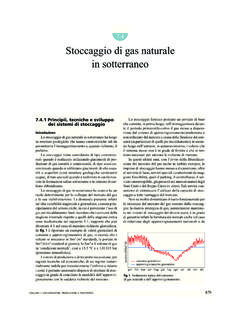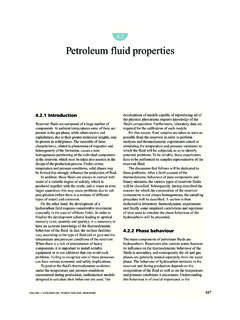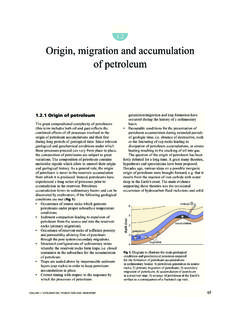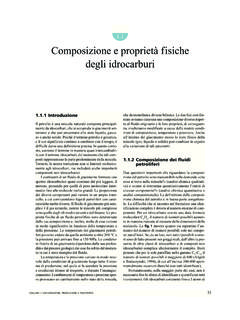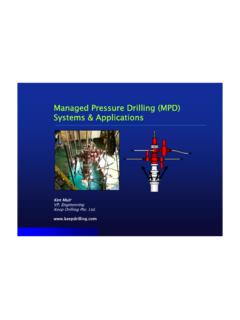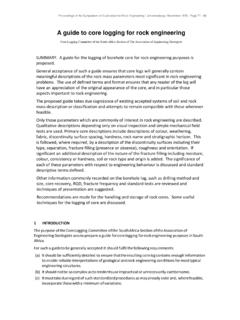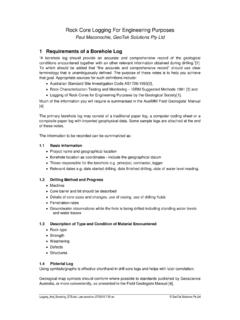Transcription of 3.4 Offshore drilling - Treccani
1 IntroductionThe techniques and equipment for drilling offshorewells ( Offshore drilling ) are very similar to thoseused for onshore drilling . The main differencesconsist in the arrangement of the drilling rig and ofthe equipment, and in certain particular methods ofcarrying out the operations, which have to be adaptedto the requirements dictated by far more difficult andoften extreme environmental conditions. Thisobviously entails considerably higher costs, to whichmust also be added considerable investments toprovide the facilities and plants for subsequent earliest episodes of Offshore drilling tookplace just after the turn of the Nineteenth century,when numerous oil fields were discovered along thecoastline of southern California, and were exploitedwith wells drilled up to the shoreline. In the attemptto follow the fields out into the open sea, it wasdecided to extend operations Offshore by positioningthe drilling rigs on piers which stuck out for about ahundred metres into the sea.
2 However, the bigdevelopment in Offshore drilling did not start until thelatter half of the Twentieth Europe, the first Offshore well was drilled in1959 in an oil field off Gela, in Sicily. Thedevelopment of the gas fields off the coast ofRavenna started in 1960 with the drilling of the firstoffshore well in Europe for the production of gas. Inthe early Seventies, the discovery of the large fieldsin the North Sea and in the Gulf of Mexico gave afinal boost to the development of increasingly refinedtechnologies for Offshore hydrocarbon explorationand the last few decades, in spite of the hostileenvironment, the difficulty, the higher investments andthe risks involved in carrying out drilling andproduction operations in a marine environment,exploration for hydrocarbons in the open sea hasundergone unprecedented development.
3 In fact,compared with onshore areas, by now explored almosteverywhere in such detail that it is considered unlikelythat any new large-scale fields can be discovered, theoceans, and above all deep-water areas (at depths ofmore than 1,000 m), still contain zones where littleexploration has yet taken place and where thepossibility of discovering large fields of hydrocarbonsstill seems promising. The costs entailed in offshorehydrocarbon exploration and production are increasingrapidly, due to the great depths of water concerned andthe hostile nature of the environmental andmeteorological conditions. For this reason, the volumeof the hydrocarbon reservoirs that can be developedand which justify investments in Offshore developmentprojects is usually very large, and depends both on theinvestment capacities of the oil companies, and on oilprices on the international Offshore drilling rig has to create the sameworking conditions as for onshore rigs which canmove from one point to another without anydifficulty.
4 It must therefore be a mobile unit equippedto contain an autonomous drilling site, including thederrick, the technical personnel and all the serviceequipment. This can be done with a supportingstructure (or platform) which rests on the seabed andrises above sea level, or with a floating structure, keptvertical above the well by means of anchors or withdynamic positioning systems (see below). Very oftenthese are isolated structures which have to house notonly the personnel necessary for ordinary operations,but also the equipment of the service companies ( cementing and logging) which in the case ofonshore drilling , on the other hand, are transported to373 VOLUME I / EXPLORATION, PRODUCTION AND Offshore drillingthe rig site and used only for the time strictlynecessary. These conditions increase the complexityof the Offshore supporting structures, and justify theirhigher daily rate, which might be up to 5-10 timesgreater than that for an onshore drilling rig of thesame an operational point of view, offshoredrilling may be subdivided into two main categories,depending on the water depth.
5 drilling with the rig standing on the seabed. Thesafety equipment, ordinary Blow-Out Preventers(BOPs) located permanently above sea level andaccessible from the supporting structure; in this casedrilling operations are practically identical to thosecarried out in onshore with floating wellhead and thesafety equipment ( special submarine BOPs) areplaced on the seabed, and are not therefore directlyaccessible from the supporting structure. In this case,a number of sequences of the drilling operationsdiffer from onshore ones, as the plant is not immobilein relation to the wellhead but, because it floats, issubject to the action of the wind, currents and waves,which cause it to make small horizontal and verticalmovements. Naturally, in this case, too, the drillingfluid has to rise to the floating rig, through a specialpipe connecting the subsea wellhead with the rig.
6 The use of floating rigs is necessary for exploratorydrilling in water depths of more than 100 m, while thegreatest depth to which it is possible to operate undersafe conditions exceeds 3,000 m. Clearly, this referssolely to exploratory drilling operations, and not tothe subsequent development drilling . Thetechnological limit for developing an Offshore fieldand bringing it into production is a water depth ofaround 1,700 m. However, this limit is bound toincrease within the next few years as technologicalinnovation in this sector is extremely active: by wayof example, it is recalled that in 1995 this limit wasless than 1,000 main types of drilling rigs for offshoreexploratory wells, with equipment designed for thesole purpose of drilling the well, are described one or more exploratory wells discover a field withreserves that justify its development, it is necessary todesign and prepare the permanent productionstructures.
7 These also either rest on the seabed orfloat, and are very often able to accommodate even arig for drilling the development wells. The permanentoffshore structures for the production ofhydrocarbons are hi-tech engineering and structuralcomplexes based on architectural concepts whichvary according to the water depth (see Chapter ). Rigs standing on the seabedSubmersible drilling pontoonsSubmersible drilling pontoons were designedin the Thirties in Louisiana, where they were used374 ENCYCLOPAEDIA OF HYDROCARBONSDRILLING AND COMPLETION OF WELLS1) towing2) hull flooding3) pontoons4) drillingpontoonpostsbarge hullFig. pontoon of the posted-barge drilling wells in the swampy areas of theMississippi delta, not accessible from ordinaryroads. In concept, the first pontoons consisted ofan ordinary rig on a suitably adapted barge, whichwas transported to the site along channels dredgedfor the purpose.
8 The barge was then filled withwater and the pontoon came to rest on the seabed,and was held firm by means of driven piles. Todaydrilling pontoons consist of a shallow-draft hull(usually 2-3 m), divided into compartments whichcan be flooded to enable the pontoon to rest onthe seabed, and emptied at the end of operationsso as to refloat the pontoon and enable it to hull is covered by one or two decks; in thecase of two, the engine-room, the mud circulationpumps, the storage area for chemical products andthe cementing unit are situated on the lower deck,while the offices, the accommodation, the depositfor tubular materials and the rig are on the upperdeck, the derrick usually being located in drilling in swampy areas, the next stepwas to conquer actual delta areas, characterized byperiodic variations in the sea level, which made itnecessary to raise the level of the deck for the rigand the various items of equipment.
9 To be able tooperate in these conditions, a pontoon wasdesigned with a hull that could be flooded, with themain decks raised over the hull using a series ofposts. In a working position, the pontoon wastransformed into a sort of pilework structure,which allowed drilling to take place in up to 8-10m of water. The typical posts used for raising thedeck gave their name to this particular type ofvessel (posted barge), usable only in extremelycalm waters (Fig. 1). They are still in use today, andthe drilling techniques applied are identical tothose of onshore this type of rig was furthermodified, to be able to operate in deeper anddeeper waters. The piling was transformed into asteel reticular structure, formed by big pipeswelded together. The outside piles, consisting oflarge-diameter pipes, were enlarged to enable themto be flooded and then emptied to make thestructure float, and allow it to be moved.
10 Theplatform placed over the reticular structure, onwhich the whole of the drill rig was housed, wascalled a submersible bottle platformbecause of itsdesign. These units, the first ones to operate in theshallow waters of the Gulf of Mexico in the 1950sand 1960s, were able to drill in depths of just afew dozen metres. The largest unit of this type,built in the early Sixties, could operate in a depthof 50 drilling platformsOffshore drilling continued to be performed indeeper and deeper waters, and to do this it wasnecessary to use a different type of plant. To limit thehigh costs necessary to construct higher and highersubmersible drilling pontoons, drilling platformscommonly known as jack-ups were devised (Fig. 2).Jack-upsare triangular or rectangular floating hullsfitted with long mobile legs (usually 3 or 4) at thecorners of the hull, which are able to move verticallyup and down.



